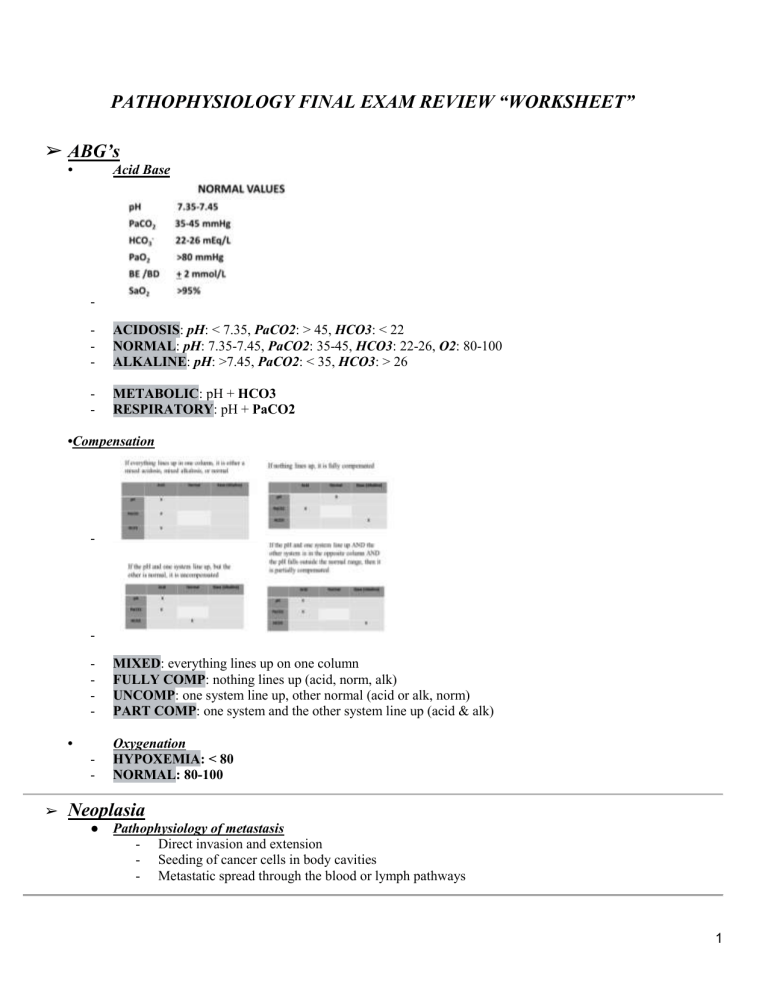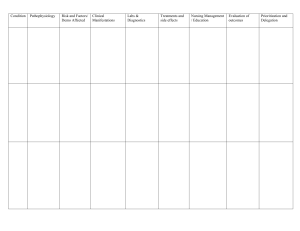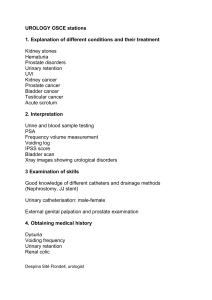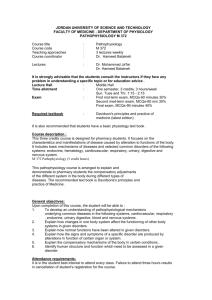
PATHOPHYSIOLOGY FINAL EXAM REVIEW “WORKSHEET” ➢ ABG’s • Acid Base - ACIDOSIS: pH: < 7.35, PaCO2: > 45, HCO3: < 22 NORMAL: pH: 7.35-7.45, PaCO2: 35-45, HCO3: 22-26, O2: 80-100 ALKALINE: pH: >7.45, PaCO2: < 35, HCO3: > 26 - METABOLIC: pH + HCO3 RESPIRATORY: pH + PaCO2 •Compensation - - MIXED: everything lines up on one column FULLY COMP: nothing lines up (acid, norm, alk) UNCOMP: one system line up, other normal (acid or alk, norm) PART COMP: one system and the other system line up (acid & alk) - Oxygenation HYPOXEMIA: < 80 NORMAL: 80-100 • ➢ Neoplasia ● Pathophysiology of metastasis - Direct invasion and extension - Seeding of cancer cells in body cavities - Metastatic spread through the blood or lymph pathways 1 ➢ Shock ● Indicators of improved perfusion after fluid resuscitations - HEMODYNAMICS: Mean arterial pressure (MAP), Afterload (SVR), Preload (RAP), CO - ASSESSMENT OF VOLUME STATUS & ORGAN TISSUE PERFUSION (HEMODYNAMICS): * Vital signs * Cardiopulmonary * Capillary refill * Pulse * Skin findings ● Pathophysiology of cardiogenic shock - CARDIOGENIC SHOCK: Heart unable to generate sufficient CO to the body (unable to meet body’s needs) - 80-100% mortality (VERY DEADLY!) - May occur in association with normal or elevated CO - HEMODYNAMICS (BLOOD): * MAP: Decreased * AFTERLOAD (SVR): Normal or increased * PRELOAD (RAP): Normal or increased * CO: Decreased - ➢ Pulmonary Embolism (PE) ● Most common sign/symptom of PE - CLASSIC TRIAD (3) SYMPTOMS: - 1) Pleuritic chest pain (sharp chest pain when breathing deeply) 2) Dyspnea (SOB) 3) Hemoptysis (coughing up blood) ➢ Eye and Ear Disorders ● Surgical management of cataracts (“cloudy eyes”) - TREATMENT: * Surgical removal of cataract and artificial lens * Implantation of intraocular lens ➢ Aortic Aneurysms and Peripheral Arterial Disease (PAD) 2 ● Pathophysiology of aortic aneurysms - AORTIC ANEURYSMS: A ballooning of an artery caused by a weakening in the wall - Etiology (cause) is most commonly atherosclerosis with hypertension - Most common site is the abdominal aorta, just above the renal arteries - Main defect is the destruction of elastic fibers in the tunica media!! - Artery balloons out during diastole - Can lead to aortic rupture ➢ Hypertension and Angina ● Modifiable risk factors for coronary artery disease - MODIFIABLE: * Elevated serum lipids (high triglycerides; high cholesterol; high lipids) * Hypertension (high BP) * Tobacco use * Impaired glucose tolerance (AKA: pre-diabetic) * Dietary habits (eating junk foods) * Physical inactivity (“couch potato”; sedentary lifestyle) * Psychological stress * Personality type (less stress/angry personality traits that cause a lot of pressure to the heart) ➢ Heart Failure ● Sign of systemic venous congestion in right-sided heart failure - Think of “swelling.” Everything gets swollen & big! Buildup of blood flow increases pressure systemically causing everything to get swollen If right side of heart “fails” to pump, blood backs up into vascular system causing edema Right heart failure causes peripheral symptoms (swelling) ➢ Cardiomyopathies and Valves ● Complications of cardiomyopathies - CARDIOMYOPATHIES: a GROUP of diseases that weaken the heart muscles - Reduces blood output and may lead to heart failure - CONSEQUENCES: * Heart failure !!! * Ventricular dysrhythmias * Atrial dysrhythmias * Cardiac conduction defects * Pulmonary or cerebral embolism * Valvular dysfunction 3 ➢ Myocardial Infarction (MI) ● Most definitive laboratory finding in myocardial infarction - 2 FORMS OF TROPONIN MAY BE MEASURED: Troponin T and Troponin I - Troponin I is the diagnostic cardiac marker (high or not) ➢ Lung Cancer ● Prevention of lung cancer - AVOID: * Smoking !!! (Dr. Tracey always says this will always be the answer lol) * Exposure to secondhand smoke (inhaling smoke from a firsthand smoker) * Previous radiation therapy * Exposure to radon gas (radioactive gas) * Exposure to asbestos (found commonly in house insulation) ➢ Urinary ● Risk factors for bladder cancer - RISK FACTORS: * Age (Over 40 years; Occurs in all age groups but mostly in elderly patient) * Gender (Men are up to 4 times more likely to get bladder cancer than women) * Occupational exposure (exposure to carcinogens like asbestos (home insulation); i.e. mechanics/construction workers) * Arsenic exposure * UTI * Urinary tract tuberculosis * Cigarette smoking * Use of tobacco products * Race and ethnicity (Caucasian 2 times more likely to develop bladder cancer) ➢ Reproductive Neoplasms ● Risk factors for testicular cancer - Age (Males 20-35 years old; Usually happens around a young age!) - Undescended testicle (cryptorchidism; teste higher than the other) - Family history of testicular cancer (runs in the family) - Others predisposing factors include such as orchitis (inflammation of testis) and HIV ➢ Bone Neoplasms ● Most common site of osteosarcomas - OSTEOSARCOMA: Most common and most often fatal primary malignant bone tumor - Most commonly found in the legs (femur; long leg bone) with pain & swelling! ➢ Gastrointestinal Neoplasms ● Laboratory findings in liver cancer - Liver Function Tests (LFTs) show… - ELEVATED: * Alanine aminotransferase (ALT) * Aspartate aminotransferase (AST) * Alkaline phosphatase (ALP) * Gamma-glutamyl transferase (gamma GT) * Alpha fetoprotein (AFP) 4 - COMPLETE BLOOD COUNT (CBC): Anemia ➢ Breast Cancer ● Breast cancer screening patient teaching - Breast Self-Examination (preferably before & after a woman's period; recommend doing in the shower in circular motions around the breast w/ soap) Women at high-risk benefit from MRI and yearly mammograms (Digital, 3D, Contrast) Annual breast exam by a physician CLINICAL BREAST EXAMS RECOMMENDED: Ages 20-39 → Every 3 years After age 40 → Annual (every year) ➢ Congenital Heart Defects ● Assessment findings in patent ductus arteriosus (PDA) - PATENT DUCTUS ARTERIOSUS: persistent opening between the two major blood vessels (AORTA & PULMONARY ARTERY) leading from the heart Acyanotic 5 - Affects the way blood flows through a baby’s lungs If it stays open longer, it cause more blood to flow to the lungs; Ductus doesn’t close Machinery like murmur ➢ Menopause and Andropause ● ● Signs and symptoms of andropause - Low sex drive - Mood instability, irrational decision making - Decreased muscle mass - Loss of muscle strength - Increased upper and central body fat - Osteoporosis or weak bones and back pain - Testicular atrophy Definition of menopause - Irregular menstruation or complete cessation (stop) of menstruation for 12 consecutive months - Menopause is when the monthly (meno) menstrual cycle ends (pause) - Purpose of menstrual cycle: prepare a woman for a possible pregnancy every month with large increases in estrogen, then, progesterone - All a woman’s eggs are present at birth. They mature at a certain age, then involute over time - When the period of fertility has ended, the body ceases to expend energy on this monthly cycle ➢ Endocrine Disorders ● Signs and symptoms of Cushing’s syndrome - CUSHings; Cushion of Steroids HIGH; Big, Round, hairy - Results from prolonged exposure to elevated levels of endogenous (in body) or exogenous(out the body) glucocorticoids - CHARACTERISTICS: * Moon face * Buffalo hump (on back) * Truncal obesity 6 ● * Purple striae (stretch marks) Pathophysiology of Addison’s disease - Adrenal crisis results from an acute exacerbation of chronic insufficiency - Adrenal hemorrhage - Steroid withdrawal !! * Most common cause of adrenocortical insufficiency - Glucocorticoid deficiency most common - Adrenal crisis is an elusive diagnosis - Severe morbidity and mortality if undiagnosed or ineffectively treated - THE MOST ABUNDANT AND PHYSIOLOGICALLY ACTIVE STEROIDS ARE: * Cortisol * Aldosterone - TRIAD (3) OF ADRENAL CRISIS: * HYPOGLYCEMIA: Primary glucocorticoid replacement (Hydrocortisone); Stimulates gluconeogenesis * HYPERKALEMIA: IV insulin and 50% Dextrose; Drive potassium from vascular space into cell; Serum potassium will decrease with shift * HYPONATREMIA: Replace mineralocorticoids ➢ Diabetes Mellitus ● ● Purpose of Kussmaul’s respirations - Kussmaul’s respirations from acidosis (2nd to acidosis; blow out CO2 to compensate breathing) - Respiratory compensation Laboratory findings in DKA (diabetes ketoacidosis) - GLUCOSE, mg/dl: >250 - ARTERIAL pH: <7.3 - HCO3, mEq/L: <15 - BUN, mg/dL: <25 - OSMOLALITY mOsm/Kg: <320 - KETONES: (Increase in ketone production) * URINE: >+3 * SERUM: (+) ➢ Intestinal Obstruction ● Pathophysiology of intussusception - INTUSSUSCEPTION: part of the intestine folds into the section immediately ahead of it - S/S: * Stool mixed with blood and mucus (sometimes referred to as "currant jelly" stool because of its appearance) !!! * Vomiting * A lump in the abdomen * Lethargy * Diarrhea * Fever ➢ Osteoporosis, Osteoarthritis, and Juvenile Idiopathic Arthritis ● Parent teaching regarding activity in the child with juvenile idiopathic arthritis (JIA) 7 - ● With appropriate use of anti-inflammatory drugs along with lifestyle modifications (regular exercise, healthy diet), a child w/ JIA stands a good chance of leading a normal life (reduce child joint pain is GOAL) Pathophysiology of osteoporosis in women - RISK FACTOR FOR OSTEOPOROSIS: Estrogen deficiency (hormone changes) at early age (< 45 years) - Osteoporosis is a risk for postmenopausal women due to estrogen deficiency that occurs because of menopause - The drop in estrogen leads to more bone resorption than formation ➢ Chronic Respiratory Disorders ● Cause of “barrel chest” ● - “Air trapping” Highest priority parent teaching for the child with cystic fibrosis - ➢ Renal Calculi ● ● Causes of renal calculi - DIET: * Proteins that increase uric acid excretion * Excessive amounts of tea or fruit juices that elevate urinary oxalate level * Large intake of calcium and oxalate * Low fluid intake - METABOLIC: * Increased urine levels of: Calcium, Oxaluric acid, Uric acid, Citric acid - CLIMATE: * Warm climates cause increase fluid loss, low urine volume, and increased solute concentration in urine - GENETIC FACTORS: * Family history of: * Stone formation * Cystinuria * Gout * Renal acidosis - LIFESTYLE: * Sedentary occupation * Immobility Composition of renal calculi 8 - Calcium phosphate Calcium oxalate Uric acid Cystine Struvite Mineral produced by bacteria in the urinary tract ➢ Chronic Kidney Disease ● ● Risk factors for CKD - Diabetes - High BP - Heart and blood vessel (cardiovascular) disease - Smoking - Obesity - Ethnicity (African- American, Native- American, Asia-American, Hispanic-American) - Family history of kidney disease - Abnormal kidney structure - Older age The kidney’s role in vitamin D activation - With disease in the kidney, the enzyme for utilization of vitamin D is absent - Kidney convert vitamin D for the body to use ➢ Disorders of Skin Integrity and Function ● ● Most likely cause of pressure ulcers (aka bedsores) - Ischemic lesions of the skin and underlying structures caused by unrelieved pressure - OTHER CAUSES: pressure, shear forces, friction, and moisture Terminology for a ringworm infection on the scalp - Tinea capitis 9 ➢ Gastrointestinal disorders ● ● ● Clinical manifestations of esophageal varices - HEMATEMESIS: throwing up blood; coffee ground appearance/emesis - MELENA: black tarry stools Laboratory findings in hepatic encephalopathy - Nitrogenous waste buildup (ammonia) in the blood, which leads to BRAIN DAMAGE - Severe liver dysfunction → increased toxins in bloodstream (AMMONIA) → brain damage Signs and symptoms of GI bleeding - HEMATEMESIS: throwing up blood; coffee ground appearance/emesis - MELENA: black tarry stools ➢ Spinal and Vertebral Column Injuries ● ● Signs and symptoms of neurogenic shock - Caused by the loss of function of the autonomic NS - BP, HR, and cardiac output decrease (Hypotension & Bradycardia) - Duration is temporary - Venous pooling occurs because of peripheral vasodilation - Paralyzed portions of the body do not perspire (loss ability to sweat below level of injury) - Spinal cord injury at T-6 or above Most likely spinal injury associated with ventilation abnormalities - INJURY OF C3 AND ABOVE: Loss of phrenic nerve function (pt will be unable to breathe completely!) - INJURY BETWEEN C3 AND C5: Loss of diaphragmatic innervation (leading to respiratory dysfunction & unable to breathe due to dysfunction of the diaphragm) - Think of Cristopher Reeve (the old Superman!) who had a C2 injury while horseback riding & was unable to breathe! 10 - - ➢ Acute Kidney Injury: Nephritic and Nephrotic Syndrome ● ● Laboratory findings in AKI that are most indicative of the recovery phase of AKI - BUN/Creatinine go back to normal & increased urine output (pt will be polyuric; greater than 30 mL/hr) Causes of prerenal acute kidney injury - PRERENAL (HEART): Hypovolemia, shock, blood loss, embolism, pooling of fluid due to ascites or burns (burn patients lose a lot of fluids), cardiovascular disorders, embolism blocking arterial (supplies to the kidney), sepsis ➢ Benign Prostatic Hypertrophy and Prostate Cancer ● Signs and symptoms of BPH - Frequent or urgent need to urinate, Increased frequency of urination at night (nocturia), Difficulty starting urination, Weak urine stream or a stream that stops and starts, Dribbling at the end of urination, Inability to completely empty the bladder 11 ● Indications for the prostate-specific antigen (PSA) blood test - Prostate specific antigen (PSA) is a protein produced by prostate cells, and can occur in high amounts when prostate cancer is present - INDICATOR FOR A PSA BLOOD TEST IS EARLY DETECTION FOR PROSTATE CANCER ➢ Autoimmune Disorders ● Clinical manifestations of systemic lupus erythematosus (SLE) - 12 - ● BODY SYSTEMS MOST OFTEN AFFECTED: Skin, Kidneys, Serosal membranes (mouth and nose), Joints, Heart S/S: Butterfly-shaped rash on the face that covers the cheeks and bridge of the nose (1st characteristic of Lupus) Colonoscopy findings in Crohn’s disease - Ulcers or inflammation - Cobblestone appearance on colon intestinal walls bc of ulcers & inflammation - ➢ Chronic Neurosensory Disorders ● Common signs and symptoms of multiple sclerosis (demyelination) - - - Patient may complain of noticeable impairment of function CHARACTERIZED BY: * Chronic, progressive deterioration in some * Remissions and exacerbations in others MOTOR MANIFESTATIONS: * Weakness or paralysis of limbs, trunk, and head * Diplopia (double vision) * Scanning speech (slurred/paused speech) * Spasticity of muscles SENSORY MANIFESTATIONS: * Numbness and tingling * Blurred vision * Vertigo and tinnitus * Decreased hearing * Chronic neuropathic pain * Pseudobulbar affect (PBA) * Episodes of sudden, uncontrollable, inappropriate laughing or crying 13 - - ● CEREBELLAR MANIFESTATIONS: * Nystagmus (Involuntary eye movements) * Ataxia (Poor muscle control, causing voluntary clumsy movements) * Dysarthria (Lack of coordination in articulating speech) * Dysphagia (Difficulty swallowing) EMOTIONAL MANIFESTATIONS: * Anger & Depression OTHER MANIFESTATIONS: * BOWEL/BLADDER FUNCTIONS: Constipation, Spastic bladder (small bladder results in urine incontinence), Flaccid bladder (large bladder results in no sensation to urinate; lack of urinating) Pathophysiology of Parkinson’s disease - Imbalance of excitatory (acetylcholine) & inhibiting (dopamine) neurotransmitters in the corpus striatum !!! Progressive; No cure Grossly affects motor function Symptoms of Parkinson's disease may appear at any age; Average age of onset is 50-60 ➢ Meningitis and Seizure Disorders ● ● Diagnostic tests for seizure disorders - Electroencephalogram (EEG) Most microorganism that causes meningitis - SEPTIC: * Caused by bacteria (Streptococcus pneumoniae, Neisseria meningitidis) - ASEPTIC: * Caused by viral infection, lymphoma, leukemia, or brain abscess ➢ Pneumothoraces ● Assessment findings of a pneumothorax 14 - - INEFFECTIVE BREATHING PATTERN: * Dyspnea (difficulty breathing) * Central cyanosis (present in large pneumothoraces) * Chest expansion (unequal) * Breath sounds (diminished/absent), * Tracheal alignment (deviated to one side in a tension pneumothorax; heart is “pancaked”/squished to one side) Impaired gas exchange (respiratory distress; minimal to severe) Pain (pleuritic) Risk for injury Decreased cardiac output Ineffective tissue perfusion ➢ Acquired Immunodeficiency Syndrome ● ● Patient teaching - ART THERAPY: Adherence to drug regimens is critical to… 1) Prevent disease progression 2) Opportunistic disease 3) Viral drug resistance Pathophysiology of a pneumocystis Jirovecii infection - Opportunistic fungal infection that affects DOGS (occur in the presence of immunosuppressed/immunocompromised pts that can attract even infections not made to attack humans) ➢ Urinary Tract Infections ● ● Contributing factors to the development of urinary tract infections in the hospital setting - Catheter associated UTIs (CAUTI) - UTI is a common cause of hospital-acquired infection, most due to urinary catheters Most common cause of pyelonephritis - PYELONEPHRITIS: kidney infection, inflammation of the kidney due to a bacterial infection. - MOST COMMON CAUSE → Gram-negative bacteria, E. Coli ➢ Infections of the Pulmonary System ● Reading of PPD skin tests o Positive 15 - ● A previous vaccination with Bacille Calmette-Guérin (BCG) vaccine usually causes a false positive reaction to a PPD skin test (this vaccine is found outside the US) o Negative - A negative reaction, the skin where you received the PPD test is not swollen, or the swelling is very small Appropriate candidates for the intranasal live, attenuated influenza vaccine - 5-49 yr olds WITHOUT chronic underlying disease ➢ Traumatic Brain Injury ● ● Patient and family discharge teaching following a concussion - Support of cognitive function/LOC - Light diet to prevent vomiting and further any injury - Physical/Mental rest Signs and symptoms of a basilar skull fracture - Not usually visible on x-ray - Bleeding from nose pharynx or ears - Battle’s sign (ecchymosis behind the ear) - Racoon eyes (bruising to the eyes) and rhinorrhea (runny nose) - CSF leak (halo sign—ring of fluid around the blood stain from drainage) ➢ Cerebrovascular Disorders/ICP ● ● Pathophysiology of a transient ischemic attack - TRANSIENT ISCHEMIC ATTACK (TIA): “warning stroke/ mini stroke” - Temporary blockage in cerebral artery - This occurs when blood flow to a vessel in the brain is briefly blocked or reduced - Symptoms resolve rapidly - A person who has a TIA is 9.5 times more likely to have a major stroke - MEDICAL EMERGENCY Contraindications for tPA administration - tPa (TISSUE PLASMINOGEN ACTIVATOR): CLOT BUSTER (dissolves clots) - Time sensitive, pt only has 4.5 hrs from time of symptoms to get treatment - CONTRAINDICATIONS: * Recent stroke * Recent head trauma * Internal bleeding * Hemorrhage 16 * High blood pressure * Pregnancy/ recent delivery ➢ Rheumatoid Arthritis ● Common musculoskeletal deformities in rheumatoid arthritis - SWAN NECK DEFORMITY (fingers) !!! (bc it looks like a swan neck (curved)) - BOUTONNIERE DEFORMITY (thumb) !!! - ● Pathophysiology of rheumatoid arthritis - RHEUMATOID ARTHRITIS: chronic, systemic disease Inflammation of connective tissue in the diarthrodial (synovial) joint Generalized aching and stiffness Autoimmune (cause is unknown) Presence of autoantibodies (Rheumatoid factor) 17 - Antigen/ abnormal immunoglobulin G (IgG) IgG + rheumatoid factor form deposits on synovial membranes & articular cartilage Inflammation results * Pannus (granulation tissue at the joint margins) leads to articular cartilage destruction Genetic * Predisposition/familial occurrence of “human leukocyte antigen (HLA) in Caucasian RA patients ➢ Hemolytic Disease of the Newborn ● Purpose of RhoGAM administration - ● RhoGAM is a medicine to stop the blood from antibodies that attack Rh positive blood cells (administered to the mother; will not help the fetus in the mother, but will help future pregnancies) - Rh-negative mothers - Administer Rh immune globulin (RhIG) as ordered * Previous pregnancy with a Rh positive infant * Current pregnancy with a Rh positive infant - Rh IMMUNE GLOBULIN (RhIG) GIVEN AT: * 28 weeks gestation * 34 weeks gestation * Within 72 hours AFTER delivery. - It prevents the sensitization to the D antigen !!! Most common cause of hemolysis of fetal erythrocytes during pregnancy - Many erythroblasts are present in the fetal blood - Immature erythrocyte, containing a nucleus - The fetus has resulting anemia from the (RBCs being broken down) hemolysis of blood cells - The fetus compensates by producing large numbers of immature erythrocytes * Called erythroblastosis fetalis (moderate to severe) * Fetalis refers to the morbid state of the infant ➢ Hematologic Disorders ● ● Prevention of sickle cell crisis - AVOID: * Hypoxia * Acidosis * Fever * Infection * Dehydration * Exposure to cold * High Altitudes Complications of leukemia - Infection (due to bone marrow depression, decreased platelets, & altered WBCs) and Hemorrhage are the causes of death 18 - Bone marrow depression increases vulnerability to infection ➢ Pain ● ● Appropriate pain scales for children - Wong-Baker FACES pain scale is the most appropriate for children Assessment of pain - SELF-REPORT TOOLS: * Most valid (Numeric Pain Scale) * Only reliable in the patient who is alert and oriented - - - Numerical scale ↑ Visual analog scale ↑ FACES scale ↑ 19 - - - FLACC scale ↑ Behavioral Pain scale ↑ Critical Care Pain Observation Tool (CPOT) ↑ ➢ Acute Respiratory Distress Syndrome = ARDS ● Diagnostic findings in ARDS - ABG: * Usually reveals hypoxemia (low O2 in the blood) * EARLY: Respiratory Alkalosis * LATE: Hypercarbia (high CO2 in blood), respiratory acidosis - CBC: 20 ● * Electrolytes, BUN, Creatinine, LFTs * Appropriate cultures - CXR: * Maybe be normal early in disease * Rapid progression of diffuse BILATERAL infiltrates * Normal sized cardiac silhouette Signs and symptoms of ARDS - May present early without S/S - Tachypnea or Dyspnea may be only manifestation - Crackles may be present - Symptoms are mild compared to CXR findings - Signs of volume overload are usually noticeably absent ➢ Acute Respiratory Failure = ARF ● ● Assessment findings in the client experiencing dyspnea Clinical manifestations of a flail chest - Fractures in two or more adjacent ribs in two or more places Bilateral detachment of the sternum from the costal cartilage Free floating unstable segment Inward with inspiration Outward with expiration Paradoxical movement ➢ Fluids and Electrolytes ● ● Definition of diffusion - The movement of charged or uncharged particles along a concentration gradient from an area of higher concentration to one of lower concentration Types of insensible fluid losses 21 - Water vapor & sweat ➢ Concepts of health and disease ● ● The World Health Organization definition of health - WHO DEFINITION: Health is a state of complete physical, mental, and social well-being and not merely the absence of disease and infirmity (1948) Examples of: o Primary prevention - Removing risk factors so disease does not occur (i.e. immunizations) o Secondary prevention - Detecting disease when still curable (i.e. pap smears) o Tertiary prevention - Preventing further deterioration or reducing complications of disease (i.e. antibiotic use) ➢ Cellular Adaptation, Injury and Death ● ● Definition of hyperplasia - Increase in the number of cells - Result in increase in size of the organ - May be physiologic or pathologic Definition of atrophy - Reduced size of an organ due to a decrease in cell size and number - 22




